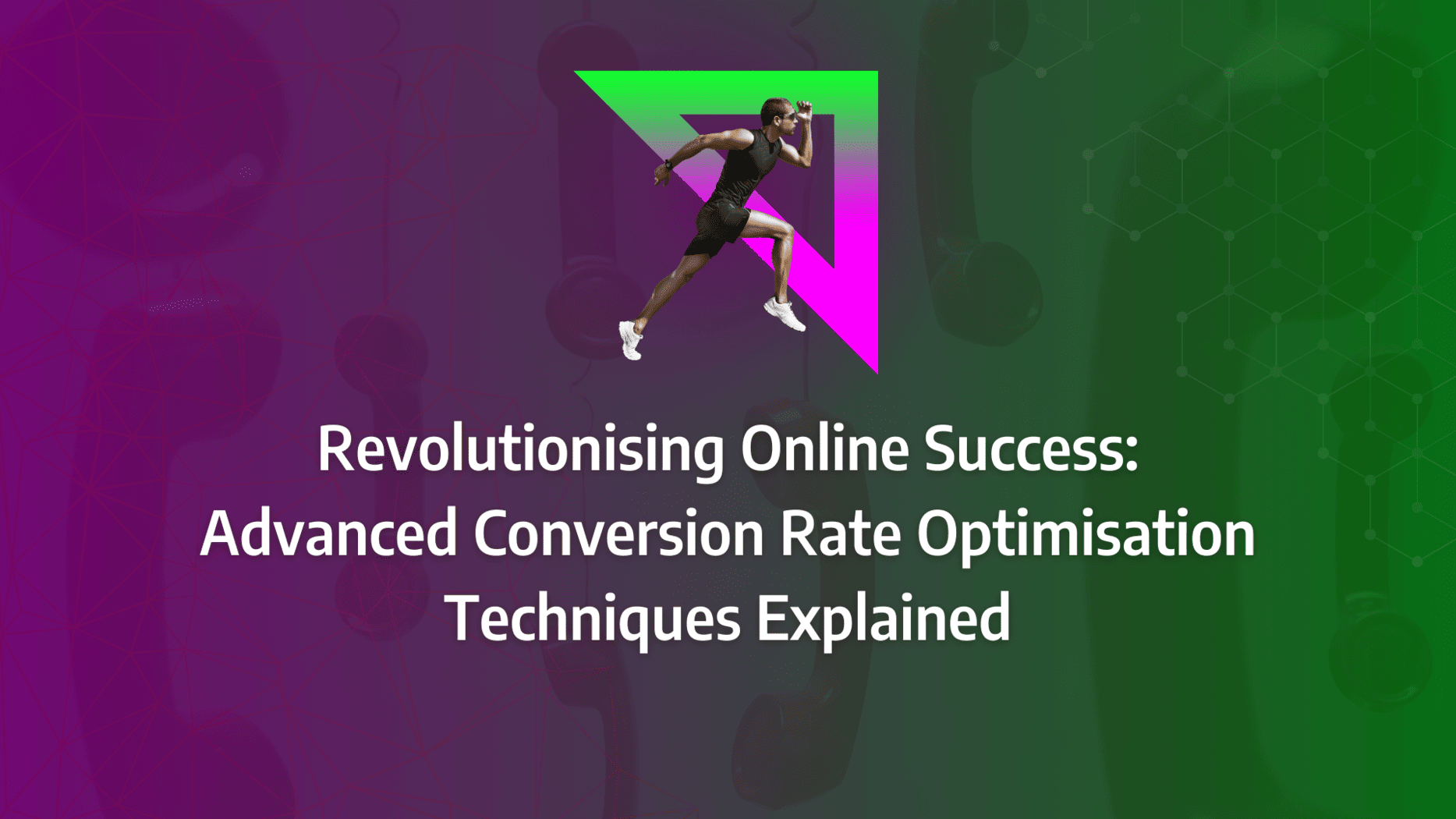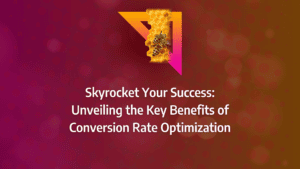Conversion Rate Optimisation (CRO) holds the key to transforming your website’s visitors into loyal customers. But to truly revolutionise your online success, you need to go beyond basic strategies. This blog will guide you through advanced CRO techniques that are not only powerful but also actionable.
From personalisation strategies to sophisticated A/B testing, you’ll learn how to make data-driven decisions that drastically improve your conversion rates. Whether you’re struggling with high bounce rates or low engagement, these cutting-edge techniques will provide the solutions you need to achieve measurable results.
- Personalisation Boosts Conversions: Tailoring content and offers to specific user segments can significantly enhance your conversion rates by creating more relevant and engaging experiences.
- Prioritise UX for Better Conversions: Optimising user experience by simplifying navigation, improving load times, and ensuring mobile responsiveness is crucial for reducing drop-offs and increasing conversions.
- Leverage Behavioural Targeting: Use behavioural targeting to deliver personalised experiences based on user actions, leading to higher engagement and improved conversion outcomes.
- Optimise the Entire Conversion Funnel: Focus on improving each stage of your conversion funnel to minimise drop-offs and maximise the efficiency of your marketing efforts.
- Enhance On-Page Content: Optimising headlines, CTAs, and visuals can drive better conversion outcomes by making your content more compelling and action-oriented.
- Utilise Data Analysis Tools: Regularly track and measure your CRO strategies with advanced tools to ensure continuous improvement and sustained success.
What is Conversion Rate Optimisation?
Conversion rate optimisation (CRO) is a strategic process aimed at maximising the number of conversions on your website by implementing various methodologies, such as A/B testing, multivariate testing, and more. CRO techniques help businesses refine their digital experiences to turn casual visitors into engaged customers.
Conversions can take multiple forms, depending on the services or products your website offers. These can include:
- Completing a sale
- Adding a product to the shopping cart
- Adding an item to a wishlist
- Signing up for newsletters or emails
To accurately track performance, businesses must monitor a range of conversion metrics. Some key metrics to consider include:
- Click-through rate (CTR)
- Time spent navigating the website
- Returning visitor rate
- Bounce rate, among others
Each of these metrics plays a critical role in shaping your conversion rate optimisation strategy, helping you identify areas that need improvement.
What Matters Most?
From our experience, understanding user behaviour through qualitative research is essential for uncovering hidden barriers to conversion. Clients often discover that developing a compelling value proposition makes a significant difference, as it clearly communicates the benefits of the offer. Additionally, implementing emotional targeting allows brands to craft experiences that resonate deeply with users, enhancing engagement and ultimately driving conversions. This strategic focus not only strengthens customer connections but also lays the foundation for more effective marketing initiatives.Get In Touch
Four Essential Conversion Rate Optimisation Tips to Boost Your Search Rankings
To effectively improve conversion rates, it’s essential to research various aspects of your site, such as user interaction, traffic patterns, and behaviour flow. Below are four conversion rate optimisation techniques that you can leverage to refine your approach and enhance your website’s performance:
Conduct Thorough Research
One of the foundational conversion rate optimisation techniques involves gathering data on user activity. Metrics such as bounce rates, web traffic, navigation time, and page visits provide crucial insights. Three valuable tools to help you track and analyse this data include:
-
- Google Analytics: A comprehensive tool that helps you monitor popular web pages, track conversion numbers, and understand visitor demographics, including age, location, interests, and even pain points.
- Website Heat Maps: Tools like Hotjar and Crazy Egg reveal how users interact with your site, highlighting the most engaging areas and helping you optimise the user experience.
- Sales Funnel Tools: Platforms such as Salesforce, HubSpot, and Leadpages enable you to track your leads’ journey through the sales funnel, pinpointing where prospects might drop off and what can be done to streamline their experience.
Formulate Hypotheses
Once you’ve gathered sufficient data, you can identify potential issues that may be affecting your conversion rate. These could involve refining your headlines, improving side banners, or enhancing the overall user-friendliness of your website. By creating hypotheses around these areas, you establish clear, actionable goals for improvement.
Test for Effectiveness
There are two primary methods for testing your hypotheses:
-
- A/B Testing: A straightforward yet effective method of comparing two versions of your website to see which performs better. Different visitors are shown either the old or new version, and success is measured in terms of clicks, conversions, and views.
- Multivariate Testing: This method allows for the testing of multiple variables simultaneously. For example, you could test three different headlines and three different call-to-action (CTA) buttons. This approach helps you determine which elements drive the best performance.
Various platforms, such as Google Optimise, Frequentist inference, or Bayesian inference tools, offer robust support for conducting these tests.
Analyse the Results
Once testing is complete, it’s time to analyse the data and assess whether your changes led to improved conversion rates or an increase in qualified leads. If the results indicate room for further improvement—whether it’s adjusting banner designs or tweaking title tags—this post-analysis stage will provide the insights needed for continual optimisation.
How Long Should You Test Your Website for CRO?
The duration of your website testing depends on your visitor numbers. To obtain statistically significant results, tools like Optimizely, AB Tasty, and EvanMiller offer sample size calculators. For example, if your sample size is 20,000 visitors and your website receives 5,000 daily visitors, you could expect to complete testing in approximately 8 days.
By diligently applying these conversion rate optimisation techniques, you ensure a data-driven approach that continually refines your digital strategy. Whether it’s fine-tuning your conversion rate optimisation strategy or experimenting with new testing platforms, consistent CRO efforts will help you achieve sustainable growth and enhanced website performance.
What are some common techniques used in conversion rate optimisation?
The success of your conversion rate optimisation strategy is intricately tied to the structure of your website and the specific marketing goals you aim to achieve. Below are four highly effective conversion rate optimisation techniques that can help you enhance the performance of your website, driving organic traffic and improving user experience.
1. Increase Website Loading Speed
Website loading speed plays a critical role in conversion rate optimisation. A slow-loading site can frustrate visitors, leading to higher bounce rates and missed conversion opportunities. To avoid this, there are several tools you can leverage, including YSlow, TinyPNG, GTmetrix, and Google Lighthouse, all of which can provide insights and solutions to improve your site’s loading times.
Improving your website’s speed not only enhances user experience but also contributes to higher search rankings, ensuring that users stay engaged long enough to convert.
2. Improve Website Navigation
Effective navigation is fundamental to a seamless user journey and a core element of conversion rate optimisation techniques. Simplifying how users move through your website helps guide them to key conversion points more efficiently. There are several methods to enhance navigation, including:
- Making the site mobile-friendly
- Incorporating a clear and accessible search bar
- Adding a mega footer for easy access to key pages
- Providing contextual information to support user decisions
By improving navigation, you significantly enhance the overall user experience, making it easier for visitors to find what they need and complete actions, such as purchases or sign-ups.
3. Utilise Web Forms
Web forms are an essential tool for collecting and managing prospect data, such as email addresses, phone numbers, and other contact details. A well-designed web form is crucial for conversion rate optimisation techniques because it streamlines data collection and improves the overall customer journey. Tools like Google Forms, Formstack, and Typeform can help you create user-friendly, effective forms that encourage visitors to provide the necessary information.
By making the process of filling out forms as smooth and efficient as possible, you can increase conversions by reducing friction in the data submission process.
4. Offer Pop-up Discount Offers
Strategically offering pop-up discount offers can be a powerful motivator to drive conversions. These offers can encourage visitors to take immediate action—whether that’s purchasing a product, signing up for a newsletter, or registering for a service. To make your offers more enticing, consider enhancing their presentation by:
- Including FAQs to address common questions
- Providing clear, user-friendly content
- Using comparison charts to highlight the value of your offer
This technique, when done correctly, can significantly boost conversion rates by capturing visitors’ attention at key moments in their browsing journey.
Additional CRO Techniques for Enhanced Website Performance
As you refine your conversion rate optimisation strategy, it’s essential to leverage comprehensive insights and implement precise adjustments that drive measurable improvements. Here are four advanced conversion rate optimisation techniques to help you boost engagement and increase conversions across your website.
1. Monitor Conversion Rates Across Mobile Devices, Browsers, and More
Uncovering hidden conversion opportunities begins with a detailed analysis of how users interact with your site across different platforms. Tools like Google Analytics provide invaluable data, revealing how visitors behave on mobile devices, specific browsers, and individual pages. To gain actionable insights, explore the following reports within Google Analytics:
- Behaviour > Technology > Browser & OS
- Behaviour > Mobile > Devices
- Behaviour > Site Content > All Pages
- Behaviour > Site Content > Landing Pages
For deeper insights, add “Device Category” or “Browser” as a secondary dimension within these reports. By focusing on key metrics like bounce rate, average time on page, and goal conversion rates, you can quickly identify areas that may be underperforming, such as pages displaying poorly on Safari or having high mobile bounce rates.
Addressing these specific conversion issues can yield quick wins. Optimising usability across different platforms not only improves conversion rates but also enhances search rankings—helping your site capture more organic traffic.
2. Tackle the Most Common CRO Issues
Whether your organisation is new to conversion rate optimisation or already well-versed, addressing fundamental issues first is crucial. Some of the most common conversion rate optimisation techniques involve resolving existing challenges that hinder conversions. These include:
- Calls-to-Action (CTAs) Below the Fold: CTAs placed above the fold are seen by every visitor upon landing on your page, whereas CTAs below the fold are often missed. Relocating CTAs above the fold ensures higher visibility and immediate engagement.
- Keyword-Stuffed Title Tags and Meta Descriptions: Over-optimising for search engines with excessive keywords can create a poor user experience. Instead, ensure that your title tags and meta descriptions are concise, relevant, and aligned with user intent.
- Conversion Tracking Errors: Verify that your Google Analytics setup is working accurately, especially if you’re using a CRO tool like Google Optimise. This will ensure that your tracking is precise, allowing you to base decisions on reliable data.
By fixing these core issues, you set a solid foundation for your conversion rate optimisation strategy, allowing you to implement quick adjustments—like repositioning CTAs—that can significantly enhance conversion rates across your website.
3. Invest in Faster Page Speeds
Page speed is critical to both search engine optimisation (SEO) and CRO. Users expect websites to load quickly, and 53% will abandon a page that takes longer than three seconds to load. A one-second improvement in load time can increase conversions by up to seven percent. Slow pages often exhibit:
- High bounce rates
- Low conversion rates
- Short time on page
Source: Landingi
Google Analytics’ Site Speed report can pinpoint underperforming pages, helping you identify which areas of your site are in need of optimisation. To begin resolving speed issues, use Google’s PageSpeed Insights tool. This platform offers actionable recommendations, such as compressing images or minifying CSS and JavaScript files. While some fixes may require developer input, many can be implemented immediately, providing a faster, smoother user experience that improves both your SEO and CRO.
If your team lacks the capacity to implement these changes, investing in professional page speed optimisation services can be a smart move. This will not only improve user satisfaction but also lead to higher conversion rates and, ultimately, greater revenue.
4. Craft CTAs That Anticipate User Needs
CTAs are the pivotal signposts on your website that guide users towards taking action. Every page should feature a well-placed, clear CTA—whether that’s inviting visitors to purchase a product, download a resource, or subscribe to a newsletter. Effective conversion rate optimisation techniques often include experimenting with different types of CTAs to see which resonates most with your audience.
When designing CTAs, think from the perspective of the user. For example, a plumbing company’s blog post on unclogging a toilet should address the user’s immediate needs, such as providing:
- Printable guides for step-by-step instructions
- Diagnostic assessments to determine if professional help is needed
The language of your CTAs should be direct and clear, offering tangible value. Examples include: “Download Your Printable Guide Now” or “Need Help? Take the Diagnostic Quiz.” Matching your CTAs to user expectations ensures they feel guided, informed, and ready to take the next step, driving conversions and building stronger customer relationships.
By aligning CTAs with user intent and experimenting with placement, language, and format, you can optimise your CRO efforts and increase engagement.
Our Tactical Recommendations
Simplifying forms is crucial in reducing friction and encouraging users to complete desired actions, which can significantly boost conversion rates. A/B testing different elements—like copy and design—enables them to identify what resonates most with their audience. Additionally, highlighting social proof on landing pages builds trust and credibility, which further encourages visitors to convert.Get In Touch
The Best Conversion Rate Optimisation Tools to Optimise Your Website
To maximise the effectiveness of your conversion rate optimisation strategy, it’s essential to leverage the right tools. Below is a selection of innovative conversion rate optimisation techniques and tools that cater to various aspects of your website’s performance, from data collection to testing and feedback analysis.
1. Quantitative Tools
Quantitative tools are crucial for gathering and analysing data, providing insights into what is happening on your website. Here are six highly effective tools to enhance your conversion rate optimisation techniques:
- General Analytics Tools: Tools like Google Analytics offer a comprehensive view of user behaviour, from page views to goal completions, helping you track the overall performance of your website.
- Website Heat Map Tools: Heat maps, such as those from Hotjar or Crazy Egg, visually display how users interact with your site, identifying the most and least popular sections.
- Funnel Tools: Salesforce and HubSpot’s funnel tools track your leads through every stage of the sales funnel, providing insight into where visitors might be dropping off.
- Form Analysis Tools: Platforms like Formstack analyse how users interact with your web forms, identifying areas where potential customers might be abandoning the process.
- Customer Satisfaction Tools: Tools such as Zendesk help gauge customer satisfaction levels by tracking support requests and overall user sentiment.
- Net Promoter System (NPS) Tools: NPS tools like Delighted measure customer loyalty by asking a simple question: “How likely are you to recommend our service?” This data can directly impact your conversion efforts by focusing on customer retention and advocacy.
Source: 99firms
2. Qualitative Tools
Qualitative tools help you understand why visitors are behaving a certain way on your website. These tools are critical for gaining deeper insights into visitor motivations and uncovering hidden barriers to conversion. Here are four qualitative tools to boost your conversion rate optimisation strategy:
- Website Feedback Tools: Platforms like Qualaroo, WebEngage, and Survicate allow you to create both on-page and off-page surveys. These surveys capture user feedback regarding their browsing and purchasing experience, helping you pinpoint areas for improvement.
- Session Recording Tools: Tools like SiteRecording, SmartLook, and Lucky Orange track real-time visitor interactions, allowing you to observe how users navigate your site. This insight is invaluable for spotting usability issues that may be preventing conversions.
- Usability Testing Tools: Tools such as Crazy Egg, UserFeel, and Optimizely let you collect feedback from users who interact with your website. This helps identify design or functionality issues that may be impacting your conversion rates.
- Online Review Tools: Tools like TrustPilot, ReeVoo, and KiyOh gather customer reviews and feedback, giving you a clear picture of how your products or services are perceived. This can be a critical part of your CRO efforts by helping you build trust and credibility.
3. Website Testing Tools
Website testing tools play a key role in conversion rate optimisation techniques by allowing you to compare different versions of your site to see which one performs better. Below are four powerful tools to enhance your testing processes:
- A/B Testing Tools: Platforms like Optimizely and AB Tasty allow you to test two or more versions of your site to determine which version drives more conversions. A/B testing is particularly useful for tweaking elements like CTAs, page layouts, and email sign-ups.
- Website Heat Map Tools: Heat map tools such as FullStory, Mouseflow, and Smartlook help you visually analyse user interactions, pinpointing the areas that are most engaging and those that may need improvement.
- Conversion-Tracking Analytics Tools: Tools like Google Analytics, Kissmetrics, and OptimisePress track and monitor key conversion metrics, offering insight into user behaviours that directly impact your conversion rates.
- Website Feedback Tools: Platforms like Pulse Insights and Qualaroo are great for capturing visitor opinions both before and after you implement website changes. This feedback helps you measure the effectiveness of updates and informs your future CRO efforts.





